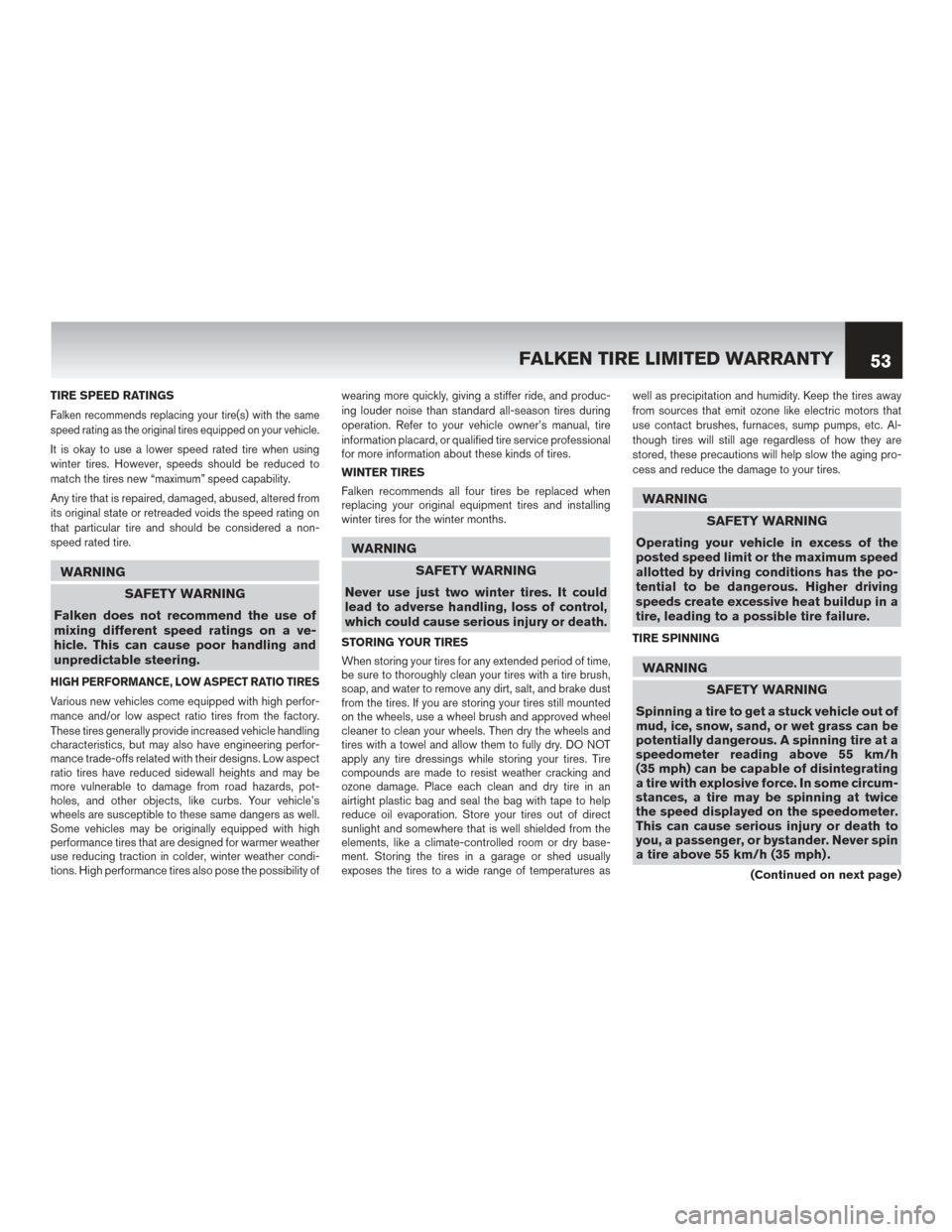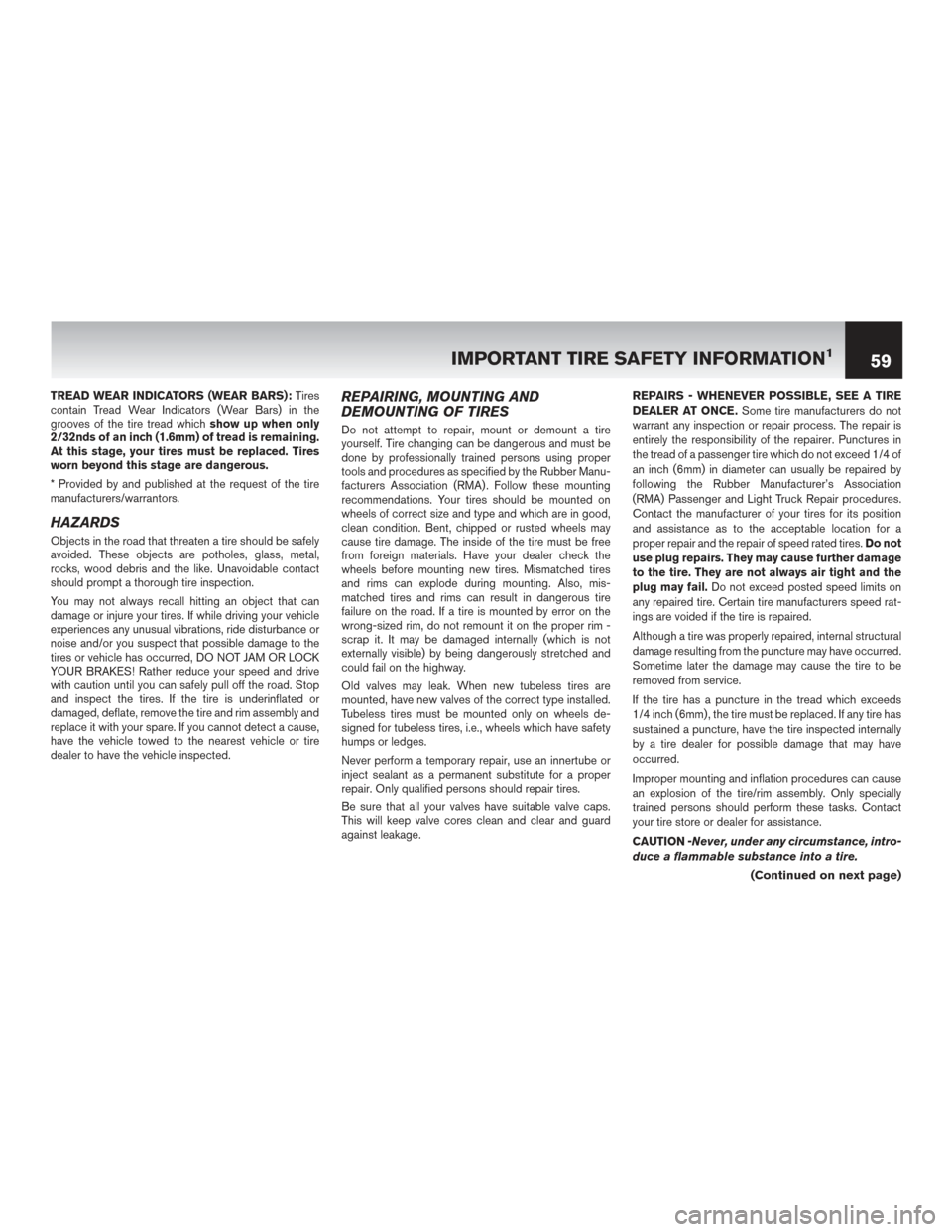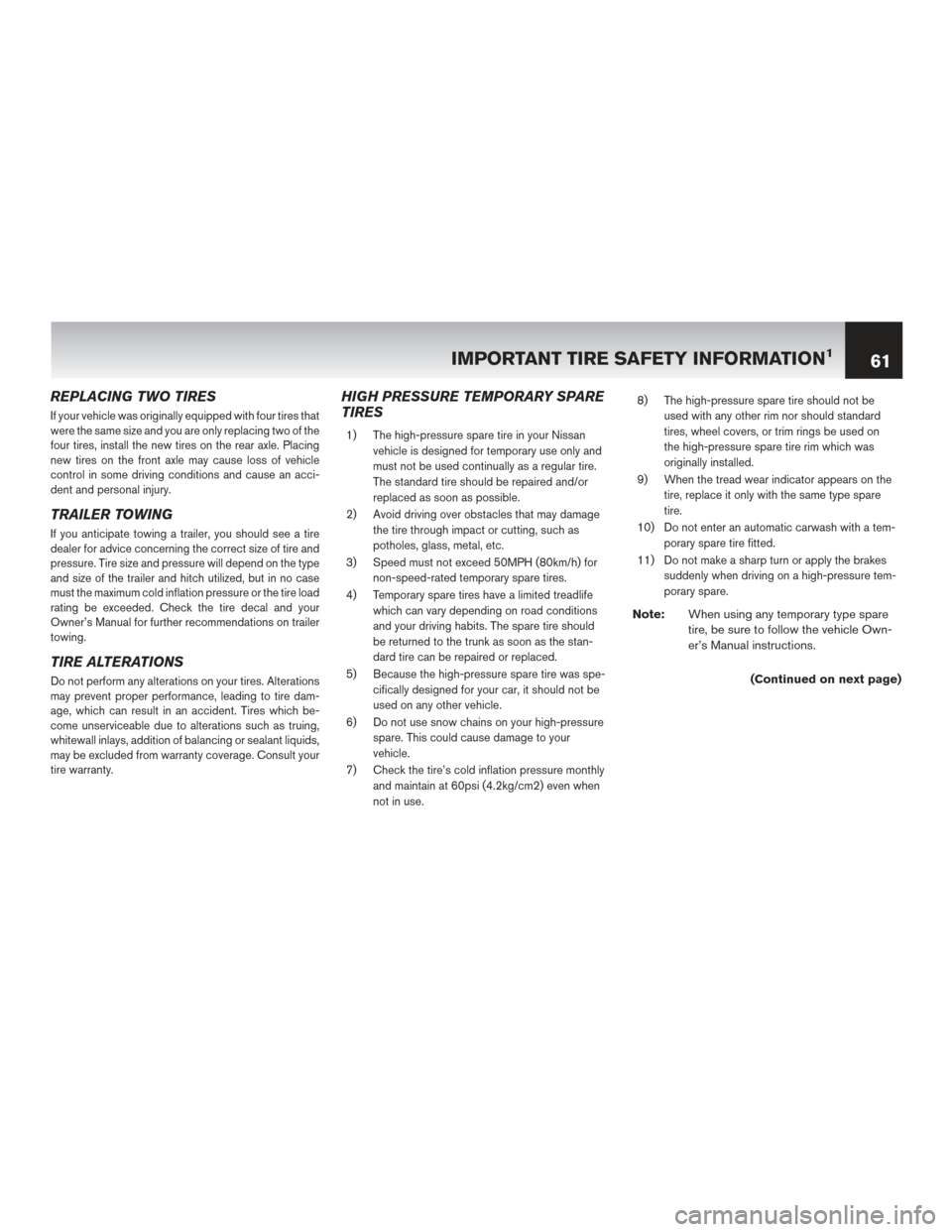2016 NISSAN GT-R brake
[x] Cancel search: brakePage 56 of 97

TIRE SPEED RATINGS
Falken recommends replacing your tire(s) with the same
speed rating as the original tires equipped on your vehicle.
It is okay to use a lower speed rated tire when using
winter tires. However, speeds should be reduced to
match the tires new “maximum” speed capability.
Any tire that is repaired, damaged, abused, altered from
its original state or retreaded voids the speed rating on
that particular tire and should be considered a non-
speed rated tire.
WARNINGSAFETY WARNING
Falken does not recommend the use of
mixing different speed ratings on a ve-
hicle. This can cause poor handling and
unpredictable steering.
HIGH PERFORMANCE, LOW ASPECT RATIO TIRES
Various new vehicles come equipped with high perfor-
mance and/or low aspect ratio tires from the factory.
These tires generally provide increased vehicle handling
characteristics, but may also have engineering perfor-
mance trade-offs related with their designs. Low aspect
ratio tires have reduced sidewall heights and may be
more vulnerable to damage from road hazards, pot-
holes, and other objects, like curbs. Your vehicle’s
wheels are susceptible to these same dangers as well.
Some vehicles may be originally equipped with high
performance tires that are designed for warmer weather
use reducing traction in colder, winter weather condi-
tions. High performance tires also pose the possibility of wearing more quickly, giving a stiffer ride, and produc-
ing louder noise than standard all-season tires during
operation. Refer to your vehicle owner’s manual, tire
information placard, or qualified tire service professional
for more information about these kinds of tires.
WINTER TIRES
Falken recommends all four tires be replaced when
replacing your original equipment tires and installing
winter tires for the winter months.
WARNING
SAFETY WARNING
Never use just two winter tires. It could
lead to adverse handling, loss of control,
which could cause serious injury or death.
STORING YOUR TIRES
When storing your tires for any extended period of time,
be sure to thoroughly clean your tires with a tire brush,
soap, and water to remove any dirt, salt, and brake dust
from the tires. If you are storing your tires still mounted
on the wheels, use a wheel brush and approved wheel
cleaner to clean your wheels. Then dry the wheels and
tires with a towel and allow them to fully dry. DO NOT
apply any tire dressings while storing your tires. Tire
compounds are made to resist weather cracking and
ozone damage. Place each clean and dry tire in an
airtight plastic bag and seal the bag with tape to help
reduce oil evaporation. Store your tires out of direct
sunlight and somewhere that is well shielded from the
elements, like a climate-controlled room or dry base-
ment. Storing the tires in a garage or shed usually
exposes the tires to a wide range of temperatures as well as precipitation and humidity. Keep the tires away
from sources that emit ozone like electric motors that
use contact brushes, furnaces, sump pumps, etc. Al-
though tires will still age regardless of how they are
stored, these precautions will help slow the aging pro-
cess and reduce the damage to your tires.
WARNING
SAFETY WARNING
Operating your vehicle in excess of the
posted speed limit or the maximum speed
allotted by driving conditions has the po-
tential to be dangerous. Higher driving
speeds create excessive heat buildup in a
tire, leading to a possible tire failure.
TIRE SPINNING
WARNING SAFETY WARNING
Spinning a tire to get a stuck vehicle out of
mud, ice, snow, sand, or wet grass can be
potentially dangerous. A spinning tire at a
speedometer reading above 55 km/h
(35 mph) can be capable of disintegrating
a tire with explosive force. In some circum-
stances, a tire may be spinning at twice
the speed displayed on the speedometer.
This can cause serious injury or death to
you, a passenger, or bystander. Never spin
a tire above 55 km/h (35 mph) .
(Continued on next page)
FALKEN TIRE LIMITED WARRANTY 53
Page 62 of 97

TREAD WEAR INDICATORS (WEAR BARS):Tires
contain Tread Wear Indicators (Wear Bars) in the
grooves of the tire tread which show up when only
2/32nds of an inch (1.6mm) of tread is remaining.
At this stage, your tires must be replaced. Tires
worn beyond this stage are dangerous.
* Provided by and published at the request of the tire
manufacturers/warrantors.
HAZARDS
Objects in the road that threaten a tire should be safely
avoided. These objects are potholes, glass, metal,
rocks, wood debris and the like. Unavoidable contact
should prompt a thorough tire inspection.
You may not always recall hitting an object that can
damage or injure your tires. If while driving your vehicle
experiences any unusual vibrations, ride disturbance or
noise and/or you suspect that possible damage to the
tires or vehicle has occurred, DO NOT JAM OR LOCK
YOUR BRAKES! Rather reduce your speed and drive
with caution until you can safely pull off the road. Stop
and inspect the tires. If the tire is underinflated or
damaged, deflate, remove the tire and rim assembly and
replace it with your spare. If you cannot detect a cause,
have the vehicle towed to the nearest vehicle or tire
dealer to have the vehicle inspected.
REPAIRING, MOUNTING AND
DEMOUNTING OF TIRES
Do not attempt to repair, mount or demount a tire
yourself. Tire changing can be dangerous and must be
done by professionally trained persons using proper
tools and procedures as specified by the Rubber Manu-
facturers Association (RMA) . Follow these mounting
recommendations. Your tires should be mounted on
wheels of correct size and type and which are in good,
clean condition. Bent, chipped or rusted wheels may
cause tire damage. The inside of the tire must be free
from foreign materials. Have your dealer check the
wheels before mounting new tires. Mismatched tires
and rims can explode during mounting. Also, mis-
matched tires and rims can result in dangerous tire
failure on the road. If a tire is mounted by error on the
wrong-sized rim, do not remount it on the proper rim -
scrap it. It may be damaged internally (which is not
externally visible) by being dangerously stretched and
could fail on the highway.
Old valves may leak. When new tubeless tires are
mounted, have new valves of the correct type installed.
Tubeless tires must be mounted only on wheels de-
signed for tubeless tires, i.e., wheels which have safety
humps or ledges.
Never perform a temporary repair, use an innertube or
inject sealant as a permanent substitute for a proper
repair. Only qualified persons should repair tires.
Be sure that all your valves have suitable valve caps.
This will keep valve cores clean and clear and guard
against leakage. REPAIRS - WHENEVER POSSIBLE, SEE A TIRE
DEALER AT ONCE.
Some tire manufacturers do not
warrant any inspection or repair process. The repair is
entirely the responsibility of the repairer. Punctures in
the tread of a passenger tire which do not exceed 1/4 of
an inch (6mm) in diameter can usually be repaired by
following the Rubber Manufacturer’s Association
(RMA) Passenger and Light Truck Repair procedures.
Contact the manufacturer of your tires for its position
and assistance as to the acceptable location for a
proper repair and the repair of speed rated tires. Do not
use plug repairs. They may cause further damage
to the tire. They are not always air tight and the
plug may fail. Do not exceed posted speed limits on
any repaired tire. Certain tire manufacturers speed rat-
ings are voided if the tire is repaired.
Although a tire was properly repaired, internal structural
damage resulting from the puncture may have occurred.
Sometime later the damage may cause the tire to be
removed from service.
If the tire has a puncture in the tread which exceeds
1/4 inch (6mm) , the tire must be replaced. If any tire has
sustained a puncture, have the tire inspected internally
by a tire dealer for possible damage that may have
occurred.
Improper mounting and inflation procedures can cause
an explosion of the tire/rim assembly. Only specially
trained persons should perform these tasks. Contact
your tire store or dealer for assistance.
CAUTION -Never, under any circumstance, intro-
duce a flammable substance into a tire.
(Continued on next page)
IMPORTANT TIRE SAFETY INFORMATION159
Page 64 of 97

REPLACING TWO TIRES
If your vehicle was originally equipped with four tires that
were the same size and you are only replacing two of the
four tires, install the new tires on the rear axle. Placing
new tires on the front axle may cause loss of vehicle
control in some driving conditions and cause an acci-
dent and personal injury.
TRAILER TOWING
If you anticipate towing a trailer, you should see a tire
dealer for advice concerning the correct size of tire and
pressure. Tire size and pressure will depend on the type
and size of the trailer and hitch utilized, but in no case
must the maximum cold inflation pressure or the tire load
rating be exceeded. Check the tire decal and your
Owner’s Manual for further recommendations on trailer
towing.
TIRE ALTERATIONS
Do not perform any alterations on your tires. Alterations
may prevent proper performance, leading to tire dam-
age, which can result in an accident. Tires which be-
come unserviceable due to alterations such as truing,
whitewall inlays, addition of balancing or sealant liquids,
may be excluded from warranty coverage. Consult your
tire warranty.
HIGH PRESSURE TEMPORARY SPARE
TIRES
1) The high-pressure spare tire in your Nissanvehicle is designed for temporary use only and
must not be used continually as a regular tire.
The standard tire should be repaired and/or
replaced as soon as possible.
2) Avoid driving over obstacles that may damage the tire through impact or cutting, such as
potholes, glass, metal, etc.
3) Speed must not exceed 50MPH (80km/h) for non-speed-rated temporary spare tires.
4) Temporary spare tires have a limited treadlife which can vary depending on road conditions
and your driving habits. The spare tire should
be returned to the trunk as soon as the stan-
dard tire can be repaired or replaced.
5) Because the high-pressure spare tire was spe- cifically designed for your car, it should not be
used on any other vehicle.
6) Do not use snow chains on your high-pressure spare. This could cause damage to your
vehicle.
7) Check the tire’s cold inflation pressure monthly and maintain at 60psi (4.2kg/cm2) even when
not in use. 8) The high-pressure spare tire should not be
used with any other rim nor should standard
tires, wheel covers, or trim rings be used on
the high-pressure spare tire rim which was
originally installed.
9) When the tread wear indicator appears on the tire, replace it only with the same type spare
tire.
10) Do not enter an automatic carwash with a tem- porary spare tire fitted.
11) Do not make a sharp turn or apply the brakes suddenly when driving on a high-pressure tem-
porary spare.
Note: When using any temporary type spare
tire, be sure to follow the vehicle Own-
er’s Manual instructions.
(Continued on next page)
IMPORTANT TIRE SAFETY INFORMATION161